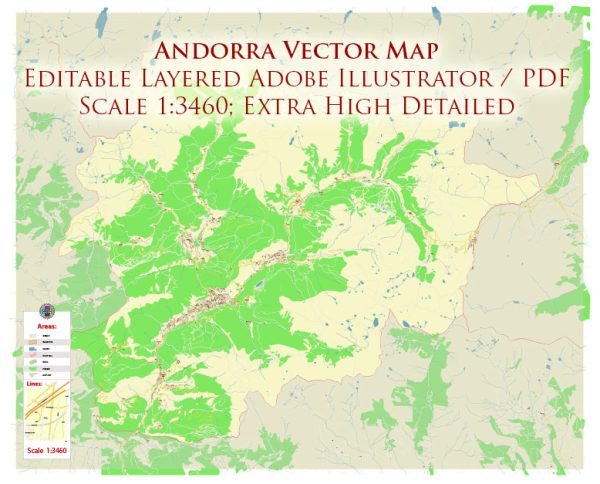Andorra is a small, landlocked country located in the eastern Pyrenees mountains between France and Spain. Its political and economic history has been shaped by its geographical location and its unique status as a co-principality.
Vectormap.Net provide you with the most accurate and up-to-date vector maps in Adobe Illustrator, PDF and other formats, designed for editing and printing. Please read the vector map descriptions carefully.
Political History:
- Medieval Origins: Andorra’s history dates back to the medieval period when it was established as a co-principality in 1278. The origins of Andorra’s political structure lie in a charter granted by the Count of Foix and the Bishop of Urgell, making them co-princes of Andorra.
- Co-Principality: The co-princes traditionally had equal authority, and this dual arrangement has persisted for centuries. Over time, the role of the co-princes has evolved, and currently, the President of France and the Bishop of Urgell serve as the co-princes, although their roles are largely ceremonial.
- Modern Political Developments: Andorra has maintained a policy of neutrality and non-intervention in external affairs. It remained largely isolated until the 20th century when it gradually opened up to the international community. In 1993, Andorra became a member of the United Nations.
- Constitutional Changes: Andorra adopted its first constitution in 1993, which established a parliamentary democracy. The constitution granted Andorrans the right to establish political parties and allowed for the election of a General Council. The head of government is the Executive Council, with the Head of Government as its leader.
Economic History:
- Agrarian Economy: Historically, Andorra’s economy was predominantly agrarian, with farming and shepherding being the primary activities. The mountainous terrain limited agricultural development, and the economy was relatively isolated.
- Tourism Development: In the mid-20th century, Andorra experienced significant economic changes with the development of tourism. The country’s tax-free status attracted shoppers and tourists, leading to the growth of the retail sector, especially in duty-free shopping and winter sports tourism.
- Diversification: In recent decades, Andorra has made efforts to diversify its economy. While tourism remains a crucial sector, efforts have been made to develop finance, technology, and other service-oriented industries. The government has sought to attract foreign investment and promote economic diversification to reduce dependency on tourism.
- Modern Challenges: Despite its economic successes, Andorra has faced challenges related to its tax haven status, money laundering concerns, and pressure from international organizations to adopt more transparent financial practices. The country has taken steps to address these issues and align its financial system with international standards.
In summary, Andorra’s political and economic history reflects its unique status as a co-principality, the impact of tourism on its economy, and its efforts to modernize and diversify in the face of changing global dynamics.


 Author: Kirill Shrayber, Ph.D.
Author: Kirill Shrayber, Ph.D.